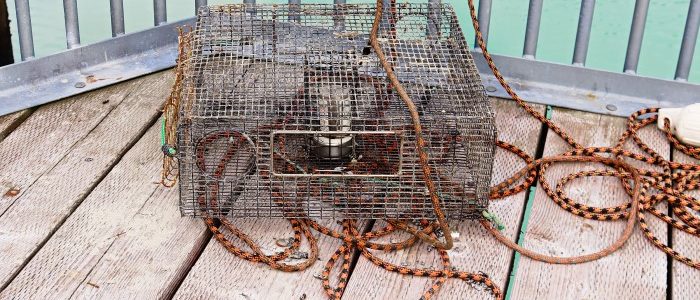
Hog Rings for Crabs & Crawfish
Crawfish & Crab Traps
- Stainless Steel vs. Galvanized Hog Rings
- Selecting the Right Hog Ring
- Using Stainless Steel Hog Rings
- Using Galvanized Steel Hog Rings
- Why Corrosion Resistance Matters
- Why Use Hog Rings to Secure Seafood Traps?
- Find Hog Rings for Your Crab Traps
More seafood harvesters are using hog rings to secure crab and crawfish traps. This is because hog rings are inexpensive, durable, and create more room in traps when compared to zip ties and other traditional metal fasteners. In addition to securing crab and crawfish traps, hog rings are also the go-to fasteners for many types of seafood traps, including oyster, shrimp, and lobster.
In this article, we’ll compare the two major types of hog rings used to secure crab and crawfish traps, what to consider when selecting hog rings, and where you can find high-quality hog rings.
Stainless Steel Versus Galvanized Hog Rings for Crawfish & Crab Traps
Stainless steel and galvanized are the two major types of hog rings you can use to secure crab traps. Both types have their advantages and disadvantages, and when selecting between the two, you’ll mostly want to consider the environment that your trap will be in. Take a look at the next two sections for a complete breakdown of each type.
Selecting the Right Hog Ring
Similar to crab and crawfish traps, when selecting hog rings for oyster, shrimp, and lobster traps, you’ll also need to consider the environment the trap will be in. Because shrimp, oyster, and lobster traps are going to be in saltwater or brackish water environments, you’ll most likely want to use a stainless steel hog ring to secure those. On the other hand, the majority of crab and crawfish traps will be in freshwater environments, so galvanized hog rings would be the better (and more affordable) choice, as they are less expensive than stainless steel and are well-suited for freshwater environments.
Using Stainless Steel Hog Rings for Crawfish & Crab Traps
Stainless steel hog rings are manufactured by adding chromium (Cr) to molten steel; chromium is known for its hardness and exceptional corrosion resistance properties. Although stainless steel rings cost more than galvanized rings, stainless steel hog rings are very strong and resistant to just about all types of water.
Using Galvanized Steel Hog Rings for Crawfish & Crab Traps
On the other hand, galvanized steel endures the effects of freshwater well, but performs poorly in seawater. This type of hog ring is called a “galvanized” hog ring because it goes through the process of galvanization. In galvanization, steel is coated with molten zinc, which improves the steel’s corrosion resistance.
Why Corrosion Resistance Matters
Corrosion in metal occurs more rapidly in saltwater relative to freshwater because of the higher levels of electrolytes, particularly chloride ions. The minerals in saltwater increase the movement of electrons over the surface of the metal, which increases the rate of corrosion the metal experiences.
In comparison, brackish and fresh water both have fewer dissolved ions than saltwater, which slows down the movement of electrons over the surface of the steel.
So, if you’re securing a saltwater trap, it’s essential that you purchase a fastener with exceptional corrosion resistance.
Why Use Hog Rings to Secure Seafood Traps?
Hog rings allow the ends of these seafood traps to remain at full width by accommodating 90-degree-angled corners. In comparison, using zip ties or cotton string pinches the ends of the traps together tightly, which decreases the interior space of the trap. As a result, the trap cannot hold as many crabs or crawfish as a trap constructed with hog rings.
Find Hog Rings for Your Crab Traps at King Steel Fasteners
King Steel Fasteners is the leading supplier and manufacturer of hog rings, hog ring tools, and other high-quality, American-made products. You can view our complete inventory of hog rings here. If you need help selecting the right hog ring for your seafood trap, call (800) 779-3762 or fill out our online form to speak with a team member.
